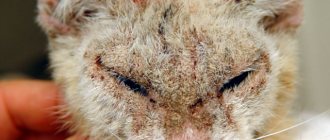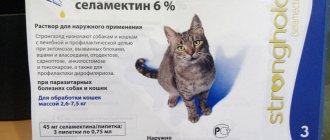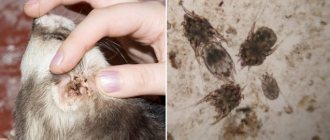The appearance of a parasite such as ear mites in a cat is the beginning of a serious disease - otodectosis., which must be eradicated at the first symptoms.
The reasons for its occurrence are completely different, but if you follow the basic rules of prevention, infection can be easily prevented. If the cat is already sick, it can be treated with simple manipulations, even at home.
What does an ear mite look like in cats?
In cats, ear mites cause inflammation of the outer ear (otitis) of parasitic origin.
Species and life cycle stages
The causative agent is the ear mite - Otodectes cynotis, which belongs to the group of acariform mites. It has an elliptical body shape, suckers on unsegmented legs and a gnawing type mouthparts. The tick feeds on the outer layer of the epithelium - the epidermis, as well as tissue fluid. Males have four pairs of paws, while in females the fourth pair is underdeveloped. The dimensions of the ear mite are from 0.3 to 0.7 mm in length and from 0.47 to 0.55 mm in width. Females are slightly larger than males. During her life, each female is capable of laying several hundred eggs, maintaining the course of the disease. On average, the development cycle of a tick is 21 days:
- After 4 days, a larva emerges from the egg, which after 3–12 days of active feeding becomes a protonymph.
- After molting, the protonymph transforms into a deutonymph.
- After the next molt, the deutonymph becomes the adult form of the parasite - the imago; Female ear mites begin to reproduce already at the deutonymph stage.
In the development cycle, the ear mite goes through an egg stage, a larvae, and two nymph stages before becoming an adult form - an adult.
They can survive in the environment at room temperature for up to 12 weeks; boiling kills them instantly.
Can it be seen with the naked eye?
Given the small size of the pathogen, it is very difficult to see it with the naked eye. In some cases, if the mites are large enough, they can be seen if you put infected earwax on black paper. Mites look like very small whitish dots, about half the size of a semolina grain, spreading across the paper. It is not possible to identify the pathogen in this way, so the diagnosis is made based on laboratory research methods.
Time of greatest activity
Ear mites are active all year round, but cats are infected somewhat more often in the summer. Apparently, this is due to the fact that in summer the pathogen is able to persist longer in the external environment.
Danger to humans
Ear mites do not parasitize humans. But in some people, the causative agent of otodectosis, carried from the ears of a cat to human skin, can cause an allergic reaction in the form of a rash consisting of papules (tubercles), accompanied by redness and itching of the skin. Once on human skin, the pathogen quickly dies and does not pose a risk of infection.
The ear mite has an oval body shape and a gnawing mouthpart.
How do cats become infected with ear mites?
The reservoir of otodectosis is cats and dogs infected with it, mostly stray ones. Among pets, rabbits and ferrets may be infected with otodectosis.
Cats become infected with ear mites:
- in direct contact with a sick animal, especially free-ranging cats;
- in some cases, fleas become carriers of ear mite eggs;
- when cats are kept in a crowded environment, infection is possible through common care items: bedding;
- toys;
- grooming tools;
- carrier bags;
The disease is highly contagious and affects cats of all ages. The most susceptible are young pets aged 1.5 to 6 months.
Infection of pets most often occurs through contact with sick stray pets.
Read also
Subcutaneous mite in a cat (Demodicosis)
Cats of different breeds and ages, both domestic and outdoor, can suffer from this disease.
Worms in cats: symptoms, signs and treatment
The first signs of infection may be absent for some time or resemble manifestations of other diseases
Sterilizing a cat: at home or in the clinic?
Sterilization is an intervention as a result of which an animal (a cat in particular) loses its ability to reproduce
Symptoms and signs of rabies in a cat
A person becomes truly afraid only when a cat bites him until he bleeds.
Ringworm in a cat: Treatment and symptoms
Ringworm is a serious infectious disease. When a cat gets sick itself, it transmits the disease to its owners.
Symptoms of otodectosis
Otodectosis in most cases affects the inner surface of the auricle, the external auditory canal and the eardrum. A small number of ticks can also be found on other parts of the pet’s body:
- on the neck;
- in the area of the sacrum;
- on the tail.
The spread of the pathogen occurs when the cat sleeps curled up in a ball.
Symptoms of otodectosis include:
- finding a large amount of brown, brown or almost black earwax in the external auditory canal, which looks very similar to ground coffee;
- scratching on the cat's ears;
- animal anxiety;
- itching in the area of the infected ear, the cat scratches the ear with its paws, and also tries to scratch it on surrounding objects;
- the presence, in addition to brown wax, of discharge from the ears, the nature of which changes from serous at the beginning of the disease to purulent with its further development. Otodectosis is complicated by the addition of bacterial or fungal flora. The discharge gives earwax a putty-like consistency. Ear mites die in the acidic environment of the inflammatory exudate, which makes it difficult to detect living mites under microscopy. Skin itching decreases, but symptoms of inflammation increase and the cat’s condition worsens;
- the presence of scabs in and around the affected ear;
- gradual deterioration of hearing, possible loss of hearing;
- possible fever;
- tilting the head downwards with the affected ear - this indicates the spread of the process to the eardrum, middle and inner ear;
- convulsions - occur with advanced disease, when the process spreads to the meninges.
Photo gallery: symptoms of otodectosis
With odecosis, secretions and inflammatory exudate accumulate in the external auditory canal; the skin may be damaged by scratching
With odecosis, discharge from the ears is profuse and dark in color.
Trying to get rid of severe itching, the cat intensively scratches its ears, which leads to skin damage.
Diagnosis of otodectosis
To make a diagnosis, the veterinarian examines the cat and asks the owner about the onset and development of the disease. Additional research methods are carried out to verify the diagnosis and, if necessary, to clarify the extent of the process:
- microscopy of earwax and scrapings from the ear is performed. Under a microscope, living mites at different stages of development are visible, and you can also determine the type of secondary flora that has attached;
- bacteriological examination - if necessary, to accurately identify the secondary flora, cultures are carried out on nutrient media;
- otoscopy - performed to assess the condition of the external auditory canal and eardrum. In case of severe inflammation of the external auditory canal, otoscopy is abstained until the inflammation decreases;
- computed tomography or magnetic resonance imaging - performed when the infectious process spreads to the middle ear, inner ear, or meninges.
To more accurately assess the distal part of the external auditory canal, as well as the eardrum, veterinarians perform otoscopy
What is not allowed during processing is prohibited
The ears of adults and kittens are sensitive and need careful attention. Doctors do not recommend when cleaning:
- use soap, iodine, vinegar, alcohol lotions, hydrogen peroxide. These drugs can cause irritation and dryness;
- use cotton swabs, wrap cotton wool around matches. This can damage the eardrum or push debris into the ear canal instead of out.
Lumps or discharge in the ears are a signal to consult with veterinarians at veterinary clinics.
Treatment of otodectosis
In the vast majority of cases, treatment of otodectosis is carried out at home, with the exception of those situations where the inner ear and meninges are affected, in these cases surgical treatment is carried out in a hospital setting.
When treating otodectosis, we are guided by the following principles:
- treatment of secondary bacterial or fungal inflammation to reduce pain and itching. For this purpose, the following are used: antibacterial agents;
- antifungal drugs;
- anti-inflammatory drugs;
- allows you to reduce the number of ear mites and secondary microbial flora;
Only a veterinarian can prescribe medications for the treatment of otodectosis.
Drug therapy for otodectosis
For drug treatment of otodectosis, the following is used:
- acaricidal drugs: ear drops: Amitrazine;
- Aurikan;
- Neostomozan;
- Tsipam;
- Surolan.
- Ivermek-gel;
- Frontline;
- Aversect;
- Sinulox;
- Clotrimazole ointment;
- Suprastin;
- Gamavit;
- Katozal;
Photo gallery: medicines for the treatment of otodectosis
Amidel-gel has, in addition to acaricidal, also an analgesic effect
Stronghold drops are applied to the skin of the withers; In order for it to work, it is not necessary to clean the ear, which is important for severe inflammation of the external auditory canal
Aurikan drops have acaricidal, analgesic, anti-inflammatory and antiseptic effects
Table: medications used to treat otodectosis
| A drug | Compound | Operating principle | Price, rub |
| Doxycycline | Doxycycline | A broad-spectrum antibacterial drug prescribed for complicated forms of otodectosis. Not for use in pregnant and lactating cats; in kittens during the period of teeth change; with decompensation of liver and kidney function, in exhausted pets | from 23 |
| Stronghold | Selamectin | Drops for application to the skin. They have anthelmintic, acaricidal, and insecticidal effects. If necessary, re-treatment is carried out after a month. Not for use in kittens under 6 weeks of age, as well as in sick and weakened animals. Not inserted directly into the ear canal. Can be used in pregnant cats | from 285 per pipette |
| Frontline Spot-on | Fipronil | Drops for application to the skin. They have insecticidal and acaricidal effects. 4-6 drops are instilled into each ear, and the remaining product is applied to the skin between the shoulder blades. After 3 weeks, the treatment is repeated. You cannot wash your cat for 2 days after treatment. Approved for use in pregnant and lactating cats. Not used in kittens under 2 months of age - Frontline spray is used for very young kittens | from 370 |
| Amidel-gel Neo |
| Gel for topical use. It has an acaricidal effect, lidocaine reduces pain, chloramphenicol is an antiseptic. The product is evenly applied to the affected areas after cleansing, covering 1 cm of healthy skin. The drug is used 2 to 5 times with an interval of 5–7 days. Not for use in pregnant cats or kittens under 4 weeks of age. | 195 |
| Aurikan |
| Ear drops. They have acaricidal, antiseptic, anti-inflammatory and analgesic effects. The drug is instilled 5 drops into each ear once a day for a week, then twice a week for a month. Data on use in kittens and pregnant cats are not provided in the instructions. | 579 |
| Otodectin | Ivermectin | Solution for subcutaneous injection. It has acaricidal, anthelmintic and insecticidal effects. Apply twice with an interval of 10 days. Not for use in kittens under two months of age; There are no data on use in pregnant cats in the instructions. | 621 |
| Tavegil | Clemastine | An antihistamine used to eliminate the symptoms of allergic dermatitis, which can cause otodectosis. Not for use in pregnant cats | from 159 |
Video: otodectosis in pets
Traditional medicine in the treatment of otodectosis
Traditional medicine is significantly inferior in effectiveness to medications, and is worthy of attention in cases where the cat needs help, but the drugs prescribed by the doctor have not yet been brought from the pharmacy. Modern acaricides can be used in both pregnant cats and kittens. In addition, to completely cure a cat, it is necessary to exterminate all ticks, including those on other parts of the body, which cannot be achieved using only traditional methods. To treat otodectosis in cats using folk remedies:
- Ointment with sulfur and potassium carbonate based on lard:
- Take 20 g of rendered lard without salt.
- Add 8 g potassium carbonate.
- Add 15 g of colloidal sulfur.
- Mix well until the ointment has a homogeneous consistency.
- Apply the resulting product to the skin of the external auditory canal and auricle 2-3 times a day until symptoms disappear completely.
- An infusion of strong green tea is used to wipe a cat’s ears to reduce inflammation.
How to properly clean a cat's ears
In advanced cases of otodectosis, inflammation in the ears can be so severe that the slightest touch to the skin of the ear causes damage to the inflamed epithelium and the formation of a hardened surface. The cat behaves aggressively, cleaning its ears is painful for it. Therefore, ears are not cleaned in such cases. Treatment begins with acaricidal drugs such as Stronghold or Frontline, which are applied to the skin of the withers; antibacterial agents are also used, for example, Sinulox, in tablets or injections. These products realize their effect by acting systemically, and they return to cleaning the ears and using drugs for local therapy when the symptoms of inflammation decrease and cleaning the ears does not result in additional injuries to the inflamed skin and the suffering of the cat.
Even if a cat tolerated ear cleaning before illness, it will resist when trying to clean sore ears. In order to clean the cat's ears, it is better to swaddle it with a towel and use the help of an assistant who will hold the cat. In the absence of an assistant:
- Prepare all the necessary ear cleaning products and wipes and place them nearby.
- Swaddle the cat in a towel and place it on your lap; this will make it easier to limit its mobility using your elbows and body.
- Open the cat's ear and assess the condition of the skin on the inner surface of the auricle and the visible part of the external auditory canal.
- With a napkin moistened with hygienic lotion for cleaning the ears or an aqueous solution of chlorhexidine, wipe the inside of the auricle and the visible part of the external auditory canal.
- After cleaning the skin, remove excess lotion or antiseptic with a dry cloth.
- Depending on the prescribed remedy, the following is carried out:
- instillation of drops;
- applying gel or ointment, they are distributed over the surface of the ear with a napkin;
- aerosol spraying.
- The cat's ear is folded in half and gently massaged at the base, promoting uniform distribution of the drug.
- Wipe the outer surface of the ear and the areas of fur around it with a napkin soaked in this preparation.
- Repeat all the steps performed with the second ear, even if it looks healthy. Use other wipes to prevent the transfer of ticks.
- Put a protective collar on the cat to prevent self-harm and release it.
- Collect all used napkins contaminated with mites, place them in a plastic bag, tie them tightly and throw them away. If possible, it is better to burn it.
Ear cleaning during otodectosis is carried out 2 times a day, when signs of inflammation subside - daily, until complete recovery.
In order to protect yourself from the cat’s claws, as well as limit its mobility, before cleaning your pet’s ears, you need to swaddle it with a towel.
What are the most effective remedies for ticks: drops, ointments or folk remedy therapy?
Finding a cure for ticks will not be particularly difficult.
To do this, you can use drops, ointments, folk remedies:
- drops on sale. You can choose a medicine for kittens, pregnant cats or elderly animals. One of the advantages of drops is ease of use.
- Ointments are the main medicine. Their range is not so wide, but they last much longer, which prevents the further spread of the mite deep into the ear. The disadvantage of ointments is that they are difficult to apply.
- Folk remedies . It is easy to prepare medications at home, but experts insist that it will not be possible to eradicate the parasite using folk remedies; it will only waste time. The best you can hope for is a reduction in the insect population.
At the initial stage of infection, it is recommended to use drops, and at an advanced stage, additional ointments should be used. Folk remedies are suitable for preventing infection during dangerous periods of the year.
Why is an integrated approach to treating your pet important?
Compliance with all measures prescribed by a veterinarian is necessary to achieve a speedy recovery, as well as to prevent re-infection. It is extremely important to combine local acaricidal agents with agents applied to the withers in the form of drops, since if all ticks are not destroyed, the disease will return. The use of antibacterial and antifungal drugs is important because the accompanying bacterial or fungal otitis media poses a risk to the cat's health. Desensitizing agents prescribed by a veterinarian effectively stop allergic inflammation that otodectosis causes in some cats and prevent the development of complications associated with it. The recovery of pets with an advanced form of the disease, as well as elderly and weakened cats, can be accelerated by immunomodulators and agents that improve metabolism.
Video: treatment of otodectosis in pets
Preparing for cleaning: what to buy
To care for pets, only specialized preparations are used, especially when cleaning the ears. The products protect against fungus and bacteria, prevent infection, and are safe for pets. The instructions for the product should indicate cleaning, not instillation. Under no circumstances should you take anti-inflammatory drugs if there is no indication for it. For cleaning it is recommended to use:
- AUROCLEAN with chamomile extract softens sulfur;
- Leopard, Dewdrop for cleansing ears;
- EAR cleaner cleans;
- Euracon Pharma Otoklin removes dead skin cells, softens sulfur, moisturizes;
- Doctor Vic softens sulfur, used before using medications;
- Veda acts as an antiseptic, heals, removes inflammation;
- Vetoquinol Otifri eliminates impurities, relieves itching, and improves the condition of microflora.
Instead of lotion, you can use saline solution, boiled water, or chamomile decoction.
Possible complications of otodectosis
Complications of otodectosis include:
- bacterial or fungal otitis - are the most common complications of otodectosis;
- hematomas and lymphatic extravasations of the auricle are also common, are the result of self-harm and require the participation of a veterinarian. Hematomas are formed when a blood vessel is damaged, lymphatic extravasates - when a lymphatic vessel is damaged by a cat’s claws. In this case, an accumulation of blood or lymph occurs in the tissues of the ear, which requires opening and draining the resulting cavity with evacuation of its contents. Otherwise, suppuration will occur, which will result in permanent scar deformation of the ear. The opening and drainage of the hematoma or lymphatic extravasation is performed by a veterinarian;
- miliary dermatitis (eczema) - develops in some cats because mite saliva and feces are strong allergens. At the same time, numerous bubbles appear in the ear area, which, when opened, turn into erosions covered with dry crusts. This increases inflammation, pain and skin itching, significantly worsening the cat’s condition;
- perforation of the eardrum and the development of otitis media and internal otitis: leads to decreased hearing up to its complete loss, but with a small hole size and proper treatment, the membrane is quickly restored;
- leads to the appearance of peripheral vestibulopathy, while: the coordination of movements in the cat is impaired;
- Characteristic is a lateral tilt of the head, the affected ear facing downwards;
- the cat can move in a circle;
- Nausea may occur when moving;
- strabismus occurs.
- extremely serious condition of the cat;
Ear hematoma often occurs during otodectosis as a result of self-injury; opening and emptying of hematomas is carried out by a doctor in a veterinary clinic
Otodectosis in kittens
Kittens are very susceptible to otodectosis, so they need regular monitoring of the condition of their ears and timely contact with a veterinarian if they suspect the development of otodectosis. When treating kittens, they are guided by the principles applicable in the treatment of adult cats, using medications taking into account the restrictions associated with the age of the kitten.
In kittens up to 4 months old, an extremely severe atypical form of otodectosis can occur, which manifests itself:
- the kitten shakes its head;
- seizures occur, including long-term ones (up to 10 minutes);
- the onset of sudden death.
Prevention of otodectosis
Measures to prevent otodectosis:
- preventive treatment with acaricidal drugs, which are often included in drugs that prevent the appearance of fleas;
- preventing cat contact with stray animals;
- regular monitoring of the condition of the cat’s ears;
- when introducing a new pet, especially one taken from the street, into an established cat community, you need to make sure that it does not have otodectosis;
- regular wet cleaning of the premises where cats are kept;
- steam treatment of beds and soft toys, regular washing of bedding;
- avoiding overcrowding when keeping cats.
If one of the cats living in the house becomes ill with otodectosis, then all pets must be treated, since otodectosis is a highly contagious disease.
Danger to humans and other animals
Many owners fear that ear mites are dangerous to humans. However, otodectosis is not transmitted to people or even small children. But for other pets the disease is dangerous, as it is easily and quickly transmitted.
It is worth remembering that a person can become a carrier of parasites without getting sick. Therefore, it is easier to keep the house clean and care for your pet than to treat it later.











